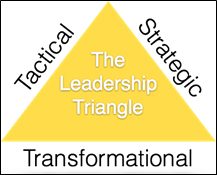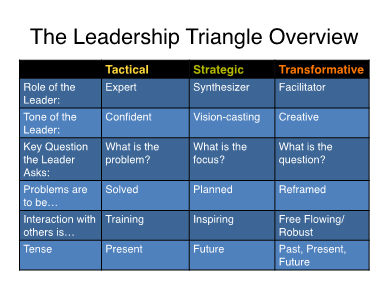The Leadership Triangle
The key to solving leadership challenges is to identify correctly the type of challenge your organization faces and the correct structure or "option" to confront that challenge.
Leading within the Christian education movement is challenging, to say the least. The complexities of enrollment, certifications and licensure, curriculum development, facility management, budgeting, the diversity of student needs and parental expectations, the shifting landscape of culture and faith, the ubiquitous nature of technology, and the complexity of family structures all converge on those responsible to lead their schools and staff—all while they are working toward positive outcomes of educating their students and having them anchored in their faith and capable of successfully leading productive, healthy, and contributive lives.
Given these challenges, what are the skills critical for leadership in the Christian education arena? I would like to offer a framework that can help you first identify what kind of challenge you are facing, and then offer insights in how to use those skills. My organization, TAG Consulting, utilizes the Leadership Triangle methodology (Ford and Tucker 2014) to identify and chart challenges.
Triage: An Essential Christian Education Leadership Skill
Leadership is more than an attribute or an activity. Leadership is also when you and your staff identify a problem and know you must choose from an array of options to tackle that problem. When the leader chooses the wrong option, the solution can become part of the problem itself. This is the unseen iceberg right underneath the waterline in the leadership challenge. A skillful leader chooses the right option, resulting in exponential success. The key to successful leadership is to understand the types of challenges you are facing so you can choose the right skills to address the challenge.
Thus, the initial critical skill for leadership is triage—identifying the challenge correctly, and then applying the necessary leadership skills critical for addressing that challenge. When you are sick and call for an appointment at your doctor’s office, the person you speak with first is not actually your doctor. Rather, the first person you encounter is a triage nurse. And when you are on the phone with that nurse, you are asked a series of questions in order to determine whether you should take an aspirin and call in the morning, make an appointment, or go to the emergency room. Triage is the single most significant initial skill the effective leader must develop. Identifying which type of leadership challenge is presenting itself is critical for successful leadership.
The Leadership Triangle

There are three primary types of leadership challenges: tactical challenges, strategic challenges, and transformational challenges. These are represented by the respective sides of the Leadership Triangle (Ford and Tucker 2014). Each challenge requires a different mode of leadership behavior in response—a different “option.” Most leaders fail to identify the type of problem, and therefore fall back on their preferred, or default, option. The art of leadership is in knowing what sort of problem you are facing and what leadership option is required to tackle it. Each problem requires a different set of skills, language, questions, and styles of interaction.
1. Tactical Challenges
Tactical issues can also be called “operational,” “technical,” or “fiduciary.” Tactical challenges are the “daily bread” of the operations-oriented manager.
Tactical issues are solved by expertise. If the roof of your school leaks, you call a roofer. If teachers call in sick, you make the necessary connections to ensure their classes and responsibilities are covered until they return. If your server crashes, you call the Geek Squad. The role of the leader is to be the expert, or the expert finder. The tone of the tactical leader must be confident; you don’t want to speak with IT specialists who think they can maybe bring your server back online, but waver in their tone and instill more anxiety than confidence. And the tense is the present. You don’t want to wait three weeks to have your roof fixed, because you’re hosting a basketball tournament and the income is critical for your sports budget—you need it fixed now! An astute leader faces tactical problems by identifying the right expert who offers the right solution and empowers the leader to solve the problem. While tactical challenges may reoccur, they can always be solved by identifying the problem and employing expertise to fix it.
2. Strategic Challenges
Strategic challenges have to do with responding to the world outside your school. These challenges are not necessarily problems to be solved, but challenges you can anticipate and goals you want to accomplish.
Strategy has to do with surveying the environment outside your department or school and deciding how your staff can best adapt to external opportunities and obstacles. For example, as options for parents increase with the use of vouchers and the emergence of charter and online schools, what opportunities and difficulties do they present for the private Christian school? What internal capacities do we have that can help us meet an external opportunity within our community? This is the work of strategic leadership: to synthesize those external challenges and opportunities with your internal capacities. And the tone of the leader is inspirational. “We can work through this successfully,” intones the strategic leader. Instilling confidence and hope and lowering anxiety are the key deliverables. The tense is in the future—directing the focus of the organization forward.
In the face of strategic challenges, tactical effectiveness is not enough. Anyone can operate effectively and still go out of business, fail in a charitable fund-raising endeavor, or coach a losing team. Strategy is when you choose a unique value proposition through a series of activities that become rooted in your system. Essentially, strategy is what differentiates your school from any other.
When you are using the strategic option, you are observing challenges rooted in the future. These challenges may transition from one generation to the next, or one era to the next. Such challenges require more than a tactical fix. Strategic challenges require you to use strategic leadership—the act of leveraging strengths in order to minimize weaknesses and capitalize on opportunities. It involves asking the question “What is the focus?” and then casting a vision that will address these problems.
3. Transformational Challenges
Transformational problems are the truly vital challenges—the ones relating to values, behaviors, and attitudes. Transformational problems are often rooted in the system and are not usually visible to the naked eye.
These are the ones that keep you up at night, the ones that tempt you to think, “We’ll never be able to solve this one!” The essence of a transformational problem is in the concept of competing values. Your real work of leadership will be done on the transformational level as you accept and even provoke conflict over values so that clarity can be reached and real change can be created.
The role of the leader within transformational challenges is to be the facilitator. And what are you facilitating? You’re facilitating conversations with the key stakeholders impacted by this challenge.
If a competitive charter school opens in your community, and your current as well as prospective families now have an attractive additional option for schooling, what is the issue at hand? What is the question? Do we improve the caliber of our teachers? Offer more diverse programs and services for our students? Hire a winning coach for our basketball team? Those are not bad options, but they aren’t necessarily the solution you should offer. The first role of the leader addressing a transformative challenge is to first ask, “What’s the problem?” And very often the answer is unclear. The role of the transformational leaders in such instances involves gathering the possible answers to the challenge, facilitating conversations as a collective, and providing a safe environment for wrestling with difficult issues.
This is challenging to do, often because of the pressure to “fix the issue” or the expectations and pressure from internal constituents and external forces. But transformative leaders must not allow those internal and external forces to compel them too quickly to a solution. If that happens, the solution presented is often tactical and will end up becoming part of your problem. Here the tone of the transformative leader needs to be curiosity; curiosity invites the stakeholders into the conversation to work collaboratively in an effort to bring insight, understanding, and ultimately solutions to the fore. Transformational challenges involve the central work of leaders: engaging those with the problem to be part of the solution.
The Leadership Triangle in Action
To begin putting the Leadership Triangle in action, consider gathering your leadership team and any involved stakeholders around a current challenge that is proving difficult to solve or manage. Explain that the first task is to diagnose what sort of problem is being addressed. Is this an issue for an expert that involves a transparent fix (tactical)? Is this an issue for an expert that involves factors outside of the organization and requires change leadership (strategic)? Or is it a deeper, systemic challenge relating to competing values and beliefs (transformational)? Once you have a handle on which type of challenge your school is facing, use the Leadership Triangle Overview chart to consider how you can move forward.
Successfully leading the Christian schools of today is a challenging endeavor and worthy of skilled leaders capable of identifying and then accurately applying the necessary skills to the challenges at hand. Leaders must first diagnose the challenge before them, then rightly apply the necessary skills to solve, accomplish, or navigate their schools toward success.
Reference
Ford, K., and K. Tucker. 2014. The Leadership Triangle: The three options that will make you a stronger leader. New York: Morgan James Publishing.
About the Author
Kurt André is a senior partner at TAG Consulting (The Armstrong Group). As an author, executive leadership coach, speaker, facilitator, and trainer, he has spent the last 30 years helping individuals, teams, and organizations navigate change. His clients include governmental agencies, private and public schools, private sector companies, and nonprofits. Kurt has multiple degrees and is an ICF Certified Master Coach. You can reach him via email at kandre@tagconsulting.org.


